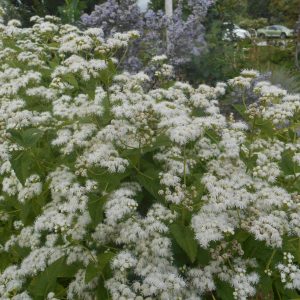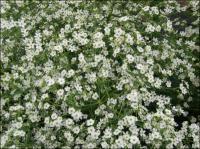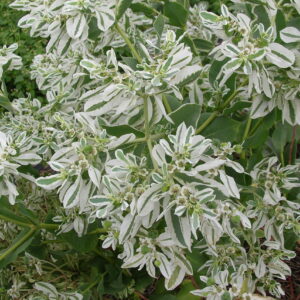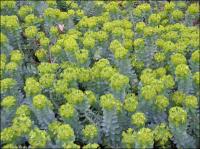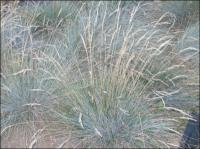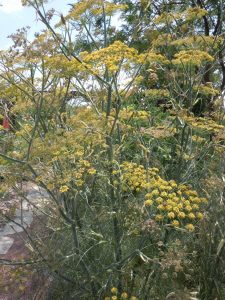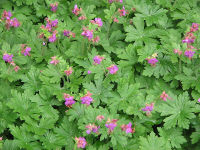Drought, Xeric & Dry Soil Plants
Showing 49–56 of 132 results
-
Eupatorium coelestinum album syn Conoclinium coelestinum ‘Album’ Mistflower ‘Album’ Z 3-7
Clusters of white in fall –close looks like a mophead of many strings, at a distance it looks like a big Ageratum - August to October.
Clusters of white in fall –close looks like a mophead of many strings, at a distance it looks like a big Ageratum – August to October.
Size: 3’ x 2-3’
Care: sun in moist to moist well-drained soil
Native: New Jersey west to Illinois south to Texas and east to Florida
Wildlife Value: attracts bees & butterflies - nectar source for American painted lady butterflyEupatorium named after Mithridates Eupator, ancient king of Pontus, Greece, said by Pliny to have used another species of Eupatorium medicinally in 1st century B.C. ‘Album’ first described and named in 1940.
-
Euphorbia corollata Flowering spurge Z 4-7
Small white flowers (bracts), like a baby's breath but better, July & August. One of the best prairie natives, but slow to mature.
Small white flowers (bracts), like a baby’s breath but better, July & August. One of the best prairie natives but slow to mature.
Size: 36' x 24" spreading slowly
Care: sun in well-drained to moist well-drained soil. Drought resistant.
Native: Canada to Florida and west through the plains, Wisconsin native
Wildlife Value: deer resistant. Its pollen & nectar feed endangered Karner Blue butterfly as well as other small butterflies, numerous bees, wasps and flies. Several birds eat the seeds.A favorite medicine among native Americans. Cherokee rubbed the plant’s juice on skin to cure cancer. Also used to remedy tooth aches and gonorrhea. Winnebago cut a 2.5” long root to clear stomach and steeped leaves for a baby’s colic. According to Breck (1851), “One of the most elegant species peculiar to the United States.”
-
Euphorbia marginata Snow-on-the-mountain reseeding ANNUAL Let seeds fall in autumn
Clean white variegated leaves and flowers (bracts), very showy midsummer to fall. Use caution with internal milky sap.
Clean white variegated leaves and flowers (bracts), very showy midsummer to fall. Use caution with internal milky sap.
Size: 18” x 10”
Care: sun moist well-drained soil, drought tolerant.
Native: Plains from Dakota to Texas
Size: Wonderful cut flower just be careful of the milky sap.Sioux crushed leaves in water and boiled it for a liniment to remedy swelling; boiled whole leaves in water to increase milk for new mothers. Collected on Lewis and Clark expedition three times, once July 28, 1806 along Marias River. A “most elegant species.” Breck, 1851.
-
Euphorbia myrsinites Donkeytail spurge Z 5-8
Chartreuse umbels at stem tips contrast succulent blue-gray foliage in early spring
Chartreuse umbels at stem tips contrast succulent blue-gray foliage in early spring
Can not ship to: Colorado.
Size: 4” x 12”
Care: Sun in well-drained soil, drought resistant
Native: Western Asia
Awards: England’s Royal Horticultural Society Award of Garden Merit.Euphorbia was named for Euphorbus, physician of Numibian King Juba, father of Ptolemy (c. 50 B.C. – 20 A.D.) Reputedly Euphorbus used spurge to remedy the King’s enlarged stomach. Euphorbus’ brother was Augustus Caesar’s physician. Myrsinites is a Greek word meaning “resembling myrtle.” This plant described by Swiss botanical scholar Conrad Gesner in his book Horti Germaniae published in 1541.
-
Euphorbia polychroma Cushion spurge syn. Euphorbia epithymoides Z 4-9
May - June flashy chartreuse flowers. In fall foliage turns orangey-red.
OUT OF STOCK
May – June flashy chartreuse flowers. In fall foliage turns orangey-red.
Size: 16" x 24"
Care: Sun, moist well-drained humusy soil. Drought tolerant.
Native: Central and Southern Europe
Awards: England's Royal Horticultural Society Award of Garden Merit.Polychroma means many colors referring to the fact that the plant changes colors with yellow-chartreuse flowers in spring and red foliage in fall. Named and described by Swedish botanist Linnaeus 1753.
-
Festuca ovina var. glauca Blue fescue Z 4-10
Short mound of silvery blue spiky grass tufts. In summer short spikes of blue-green flowers.
Short mound of silvery blue spiky grass tufts. In summer short spikes of blue-green flowers.
Size: 12" x 10"
Care: full sun, well-drained soil
Native: temperate areas in Europe
Wildlife Value: host for larvae of a few butterfliesFestuca is Latin meaning “grass stalk..” This variety described and named in 1881
-
Foeniculum vulgaris ‘Purpureum’ Bronze fennel Z 4-9
Yellow blooms on flat-topped umbels in late spring into summer, features dusky purple, feathery, compound, aromatic purple leaves with needle-like segments.
Yellow blooms on flat-topped umbels in late spring into summer, features dusky purple, feathery, compound, aromatic purple leaves with needle-like segments.
Size: 4-5’ x 2-3’
Care: sun to part shade in well-drained soil. Drought tolerant.
Native: Mediterranean
Wildlife Value: attracts bees and birds. Nectar plant for Swallowtail butterflies. Flat-topped surface gives insects a landing pad.Ancient Egyptians used fennel as food and medicine. Considered a snake bite remedy in ancient China. During the Middle Ages it was hung over doorways to drive away evil spirits. Fennel is also associated with the origin of the marathon. Athenian Pheidippides carried a fennel stalk on his 150-mile, 2-day run to Sparta to gather soldiers for the battle of Marathon with Persia in 490 B.C. The battle itself was also reportedly waged on a field of fennel. The Gardeners Dictionary, eighth ed. 1768.
-
Geranium macrorrhizum Bigroot Geranium Z 4-8
Five raspberry-purple open petals showcase its tall, purple stamens beckoning come hither to bees. Blooms in early summer. Fragrant foliage smells like pine trees at Christmas. Good groundcover in dry shade
Five raspberry-purple open petals showcase its tall, purple stamens beckoning come hither to bees. Blooms in early summer. Fragrant foliage smells like pine trees at Christmas. Good groundcover in dry shade
Size: 20" x 24"
Care: part shade in moist well-drained to well-drained soil
Native: Southern Europe
Awards: Elisabeth Carey Miller Botanical Garden Great Plant Pick.Geranium is Greek meaning “crane” referring to the shape of its seed resembling the bill of a crane. Cultivated in England by 1600.

